Shay passed away 22 months after his diagnosis with a glioblastoma. The eldest of their three children, his parents Niki and Deenu weren’t prepared to give up on Shay and did their utmost to find alternative options for his clinical care, going to the United States, as well as Germany. Sadly Shay’s experimental treatment came to an end because of the coronavirus pandemic.
Shay’s mother Niki tells his story…
Shay was our eldest child and very smart. He loved anything sporty including tennis and cricket, but football was his real passion with Shay going to football training five times a week (twice a week at the advanced centre at MK Dons) as well as playing matches on Saturdays for his local club Woburn & Wavendon Lions.

In the autumn of 2018, he moved up from Bedford Modern’s Junior School into Year 7 at the Senior School. We went to Cyprus during the October half-term with extended family and had a fantastic holiday; there was no indication that there was anything wrong with Shay.
One night soon after our return, Shay had a nightmare, which he told us about the next morning. A couple of days later, he appeared in our room at 5am, saying he had had another nightmare. His dad, Deenu and I let him get into bed with us.
After a while, we became aware that Shay was acting strangely and then he started shaking. After initially thinking he was messing around, we realised he was having a full-on seizure.
We called an ambulance and by the time they got him to Milton Keynes University Hospital, Shay was laughing and joking and seemed totally normal. Our worst fear was he had epilepsy.
Shay underwent a CT scan, followed by an MRI. The news that Shay had a brain tumour, probably low-grade, which was delivered to us at Shay’s bedside, came totally out-of-the-blue. I remember it was all a bit of a blur and it still hadn’t hit us it was anything serious, even when he was being transferred to the John Radcliffe Hospital in Oxford.
Shay was admitted and we were told he would probably be having surgery the following week. Shay was very nervous because he found himself on the same ward as his brother Dylan had been many times over the years, following his birth with a cleft palate and lip. Dylan had undergone 10 different surgical procedures whilst on the ward, including one very recently.
That weekend we had lots of plans, including celebrating Diwali and Dylan’s 10th birthday with a party. In the end, the family continued with Dylan’s party, with me popping back home briefly.
Meanwhile, Shay was given steroids to bring down the pressure in his head, as well as anti-seizure medication. We thought he was going to have surgery to have the tumour removed.
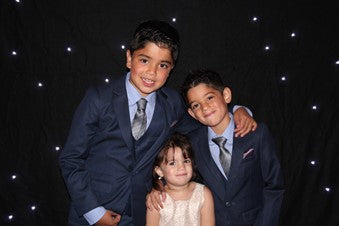
On the Wednesday morning Shay went down for surgery, and at this point we were still expecting him to have a resection. Sadly, the surgeons were only able to attempt a biopsy, but had to stop because Shay had started to bleed. They weren’t even sure they had managed to get tissue from the right spot, which sadly turned out to be the case.
The following day, Shay was quite subdued and started showing some worrying symptoms; his space perception was off and he told me that I seemed very far away. The nurse explained it was because of the morphine. However, after a change of shift, another nurse checked his pupils and could see that one was massive while the other tiny. Shay was sent for a CT scan which revealed he had a big build-up of fluid on the brain which was caused by the bleed blocking his ventricle. He was immediately taken to ICU and put on a ventilator.
Within hours, things had taken a turn for the worse and Shay was being prepared for emergency surgery to drain the fluid from his brain. As we signed the consent form, we were warned that Shay might not make it.
Fortunately, he came through the procedure, although the medics still hadn’t been able to take a biopsy. Shay spent over a week with an external ventricular drain (EVD). During this time, with Shay having a third surgical procedure, surgeons were successful in obtaining a biopsy.
It was humbling to witness, throughout his time in hospital, Shay being more worried about the other children, than himself.
Towards the end of Shay’s third week in hospital, we got the histology results.
We had a meeting with the doctors and on entering the room saw a box of tissues and knew the news was not going to be good. We had been told beforehand they believed the tumour was high grade, and that stage three meant a difficult journey and stage four indicated a very difficult journey. During this meeting, they delivered the devastating news that it was a stage 4 tumour, and we were given a scrap of paper with glioblastoma multiforme (GBM) written on it. There was no discussion about life expectancy.
As only one parent was able to stay with Shay at night, Deenu and I were swapping over with one of us staying in a hotel every other night. It was one night when I was on my own in the hotel that I decided to google GBM and it was only then I realised Shay’s prognosis was so bleak and that it was a terminal diagnosis.
Being a lawyer, I started an ongoing process of research to find options for Shay, including using avastin and repurposed drugs, only for our hopes to be dashed when Shay’s oncologist discouraged us, advising there was ‘no evidence’ any of these treatments worked.
We finally got home towards the end of November 2018 and Shay had about two weeks before he started radiotherapy and chemotherapy treatment. He was fitted for a mask during this time and the consultant stressed that this was palliative treatment.
I was feeling completely overwhelmed and exhausted and couldn’t believe this was happening to my eldest child. But I read about people who had beaten it, or were long term survivors including a woman from our town who had the DC Vax-L vaccine (made from a patient’s own dendritic cells) in the US. I remained hopeful we could find someone who could help Shay.
Meanwhile, we never told Shay his condition was terminal.
How can you tell an 11-year-old: ‘You’re dying’?
On the other hand, Shay knew it was serious and would say: ‘We’re going to fight this, Mum!’
During those weeks before treatment started, good friends of ours got in touch with Mercedes and managed to arrange for Shay to meet Lewis Hamilton and Valtteri Bottas – he even got to sit in Lewis’ car and wear his helmet. We also took him to see his favourite team Chelsea play, with the club surprising him with meeting the players he idolised after the match.
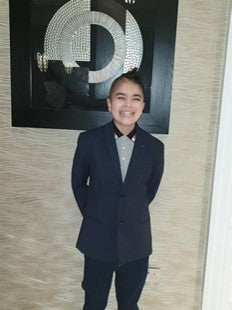
Shay was ok during his first week of treatment, but over Christmas he wanted to lie in a dark, quiet room. On Boxing Day, a friend got us tickets to see Watford v Chelsea and Shay was able to watch in the quiet sensory room designed for autistic children.
As the weeks went on, Shay began to have a bit more energy and managed to go into school for short visits towards the end of January.
We took the family to the United States during the February half-term, having requested an extra week off school. On the flight out to Las Vegas, Shay started having focal seizures back-to-back which developed into a full tonic-clonic seizure mid-air about an hour and a half from our destination. We had been used to him having focal seizures before, but this was the first full seizure since his diagnosis. With no doctor on board, we were very fortunate that Shay came out of the seizure on his own.
An ambulance met the plane and Shay was taken to be checked out in hospital, only to be discharged by medics saying it was a panic attack.
We got in touch with his oncologist about increasing his anti-seizure meds because we were terrified about getting on another plane to San Francisco a few days later. In the event, Shay was fine on the flight, but then had another full seizure one day in San Francisco. He was taken by paramedics to hospital and couldn’t move his left side on arrival. We were very concerned that his tumour was progressing, but his CT scan didn’t seem to show change.
Over the next few days, he was observed in ICU at Stanford Hospital, but thankfully Shay bounced back. Our insurance company tried to get us to fly home, but we felt he needed time to recoup and that it wasn’t a good time to get him back on a plane. We managed to spend a fun week in Los Angeles where we watched a Lakers game and then we flew home with an air paramedic flying with us, arranged by the insurance company.
We also took Shay to Madrid to watch El Classico – Real Madrid v Barcelona. We had an amazing time and Shay had no problems flying. We were trying to tread a fine balance of creating memories safely without exhausting Shay.
Before Shay started further chemotherapy at the beginning of March 2019, I discussed with the oncologist the possibility of Shay having a combination of lomustine and temozolomide and was pleasantly surprised to find he was open to it.
Shay had an MRI scan at the end of the first cycle and they weren’t sure whether the tumour was showing progression. Nevertheless, he continued onto another cycle of chemo.
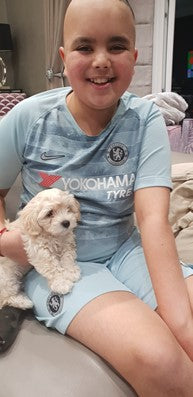
By May and another scan, Shay seemed stronger. He was weaned off the steroids, although still on anti-seizure meds. We also introduced some repurposed drugs including cannabis and Shay was following the ketogenic diet.
Then results came back from the scan showing the tumour had progressed. We were told that the chemo wasn’t working. We sought second opinions which all concurred that there was progression.
We asked the oncologist for other options but he had nothing to offer. He wanted to stop the chemotherapy and put him on second-line treatment or palliative care.
It was devastating to hear – Shay seemed so well!
We continued to search for other options, including potential trials, although this was all through our own efforts. We found a clinical trial at University of California San Francisco (UCSF) and were in the fortunate position to be able to fund this ourselves as we knew we had little time to access the treatment.
Although the trial paperwork wasn’t completely sorted, we flew out on 4 July, not wanting to wait any longer in case Shay started to deteriorate and was unable to fly. We paid for a paramedic to fly with us in case Shay had another seizure.
It was difficult being far away from home and our other two children were with family, but, despite knowing we would have a few weeks to wait until the trial could start, we were desperate for Shay to receive the experimental drug. The pre-trial MRI was arranged a few weeks later and the following day we met with the doctors in person for the first time.
Shay was just about to start the trial when we were told he was no longer eligible – the scan showed the part of his tumour that had caused concern had halved in size since the scan six weeks earlier. What had been seen was pseudo-progression and this was the best possible news, we were absolutely over the moon.
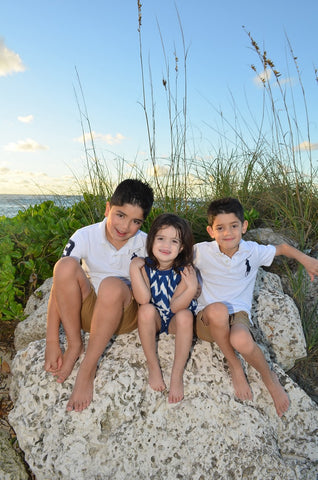
As we had leased an apartment, we decided to stay in San Francisco for a while and a friend flew out with our other children as soon as the school term ended. Shay had another cycle of chemo with UCSF and we managed to get down to Los Angeles and San Diego and spend time with family we had there, as well as family and friends who flew out to see us. The fact that we flew out only for Shay to then be ineligible for the clinical trial turned out to a blessing in disguise – we made so many wonderful memories.
Shay had another scan at UCSF at the end of August which showed that he was stable, with possibly a slight improvement. At this point we felt confident to take him back to the UK, as we had wanted to make 100% sure his tumour wasn’t recurring. We could have just gone down the palliative care route as discussed in Oxford, but felt so pleased we had gone with our gut.
Shay had another three cycles of chemo back in the UK, finishing towards the end of 2019. We started to look at further options now his standard of care was coming to an end and I flew out to Germany to talk to a doctor about peptide vaccines who went ahead with genome sequencing on Shay’s tumour.
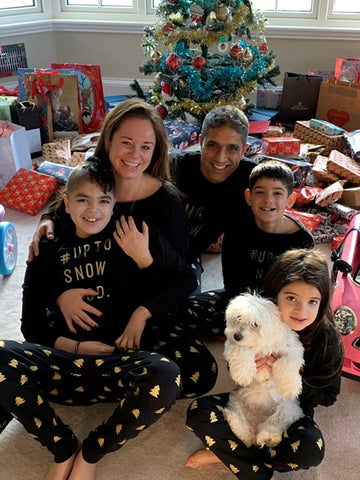
Shay started on the vaccine in early 2020, but with the coronavirus pandemic kicking in, it became more and more difficult for him to have his monthly vaccine. He really needed six months of treatment to make a difference and this tragically didn’t happen.
Added to this, Shay was unable to see his friends because of the pandemic, which in hindsight is even more sad, given that these weeks were the very last he would have been well enough to enjoy their company or play football together.
In May, Shay started to have symptoms again. He was having focal seizures a couple of times a day since diagnosis, but one day he told us he had got out of bed, fallen down and not been able to get up again. This rang alarm bells and I slept in his room with him for a few nights. On one of these mornings, he also caught his leg on his duvet and fell, hitting his head. We took him to hospital to get checked out for concussion.
A few days later Shay dropped a glass out of his left hand, and then had a further episode of being very unsteady on his feet. They were all worrying things which led Shay to be put back on steroids.
The results of an MRI scan, later the same month, showed the tumour was back and growing.
This time the options were so restricted because, due to the pandemic, nobody was recruiting for clinical trials and overseas travel was almost impossible with the scary potential for Shay contracting COVID on top of everything.
It was very difficult to know what to do. In the end, we went with second-line chemotherapy which meant 21 days on and seven days off.
Shay continued to decline until he couldn’t move his left side. A scan in June showed rapid progression. Shay was sleeping all the time.
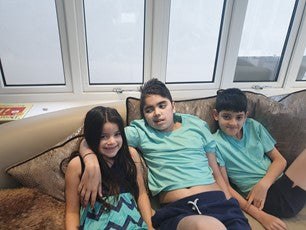
We were trying to help Shay walk, because he could no longer do this unaided. But he became either bed-bound or in a wheelchair. It was clear we were losing him, but we still saw flashes of his funny personality and beautiful smile.
By August, Shay was no longer able to talk. He had episodes when his eyes would roll up into his head. He also suffered a blood clot in his leg.
Then Shay developed pneumonia and had to be put on oxygen. He also had a feeding tube fitted which was also used for his medication because he had lost the ability to swallow.
On his last trip to see the oncologist in Oxford, Shay didn’t really know what was going on. We were still trying to find other options but COVID made everything so difficult. It was becoming clear too that treatment wasn’t going to help him. The hospice palliative care team took over Shay’s care and we found ourselves having discussions about end-of-life care and had to sign a ‘do not resuscitate’ (DNR) order.
A few days before he passed, we didn’t realise how close to the end Shay was. Nurses were coming every day to administer injections for the blood clots. Then one very caringly took me to one side and said she thought Shay could die at any time. I am glad she said that because it gave everyone a chance to come and say goodbye.
Just two days later at 7.31am on 1ˢᵗ September 2020 Shay passed away. Dylan sitting beside him, begging him to keep breathing, will be a memory that will haunt me for ever.
Shay had always been really upbeat, even in hospital and had such an impact on a lot of people, including my aunt who had been diagnosed with breast cancer. She was so inspired by how Shay dealt with his treatment, taking everything in his stride and always with a smile on his face. Even the nurses would say he made them laugh.
Before he died, Shay knew we were going to set up a charity called Shay’s Smiles because he always wanted to help other children. We want to find real options for children diagnosed with glioblastoma multiforme and support the families of children with this heart-breaking diagnosis.
As a parent told your child has cancer, or a brain tumour, you assume in this day and age there will be something to increase the odds and give you hope. The harsh reality with this tumour is that there are no such treatments.
Shay survived 22 months from diagnosis. I don’t think the doctors expected it would be more than six because his tumour was so large and so diffuse. The MRI images showed a shadow over the whole of the right side of his brain.

I can’t believe that funding of research into brain tumours continues to be so poor and that GBMs are still quoted as being rare when we have met so many patients, including children, through Shay’s journey, many of whom have since passed. GBM is certainly not rare. There will be no change and no hope without more funding for research. We can’t let another 10 years go by, destroying families and taking more and more young children from their parents. We need the Government to act now and increase investment in order to help charities fighting to find a cure for this devastating disease.
Niki O'Dea-Patel
April 2021
Brain tumours are indiscriminate; they can affect anyone at any age. What’s more, they kill more children and adults under the age of 40 than any other cancer... yet just 1% of the national spend on cancer research has been allocated to this devastating disease.
Brain Tumour Research is determined to change this.
If you have been inspired by Shay’s tragic story, you may like to make a donation via www.braintumourresearch.org/donate or leave a gift in your will via www.braintumourresearch.org/legacy
Together we will find a cure.

